Unchecked human activities and negligence from all three tiers of governments turning far-flunh mountain forests into eyesores. A story of environmental degradation and climate change induced crisis.
Basanta Pratap Singh | CIJ, Nepal
In the third week of May 2021, Juna Budha of Tallokot village in Bajhang was searching for yarsagumba in Majaban high pass. She arrived with her two children aged 8 and 11. For 65-year-old Budha, it took four days to reach the 5100-meter high Majban pass. She was unable to get even a single yarsagumba despite spending eight days in the middle of the jungle. She was more worried about the safety of her children rather than collecting yarsagumba.
Three years ago, her daughter Rekha disappeared from the same place while crossing a stream. “What do I eat if I don’t bring my children to collect yarsagumba? They are too little to cross accident prone streams. That’s why I’m also following them,” Juna shared her compulsion.

A few scant forest patches are left in the Raidhungi area of Saipal Rural Municipality after massive deforestation of mountain forest in Bajhang. Photos: Basanta Pratap Singh
Juna came to this forest first together with neighbors when she turned seven. “At that time, streams were not so wild, no fear at all. These days, water level rises in the stream in early May. How can I send my children alone?” she recalled her childhood days to remember changes she has been facing in recent days.
Streams around the forest were in existence long ago. But the local stream Majagad, which swept away Juna, used to remain completely frozen till mid-July. One could easily walk over frozen ice and cross the stream. These days, the same stream starts to melt from mid-March and floods begin to sweep away surrounding things in Mid-April. The Majagad has swept away seven persons in recent five years while trying to cross over it.
“Previously, snow used to start melting when the yarsagumba harvesting season was over and collectors returned home. These days, floods sweep away the people in May. It seems this earth is collapsing soon,” Kamman Bohara, 69, expressed his worry over fast changing climate conditions in his areas.
Just a decade ago, the Gaderi Khola used to remain frozen until July so that people could cross it without removing their shoes. “In case of massive snowfall, one could cross the stream walking over snow till August,” Gorakh Bohara of Kanda recalled, “It’s been a decade or so we haven’t seen serac over stream to walk, wooden bridges are used to cross the stream throughout the year.”
Bohara says snow bridges like serac were formed over steam upstream of his village until five years ago. Those serac used to be utilized to collect fodder, yarsagumba, salt, herbs, walk to Tibet of China to buy clothes and daily essentials and take Himalayan goats to high passes. “Now, no snow bridges. Every year at least two people die in floods triggered by snow melting,” said Bohara.
More than 50 people have died in the last 10 years while crossing streams, according to records compiled by Saipal Rural Municipality. Altogether 67 people from other local governments in the district namely Surma, Chhabisa, Pathibhera, Masta, Talkot and Jaya Prithivi died in the floods over the same time period.
Crisis has begun
It’s hard to explain the devastation of climate in the region as people regularly die in floods and snow is disappearing in mountain regions. In Bajhang, mountain biodiversity is on the verge of collapse because of rising temperatures and unchecked development. Both glaciers and other water sources have dried up. Forest, herbs and wildlife are disappearing faster than expected making the once green mountain range a high mountain sanitary landfill site.
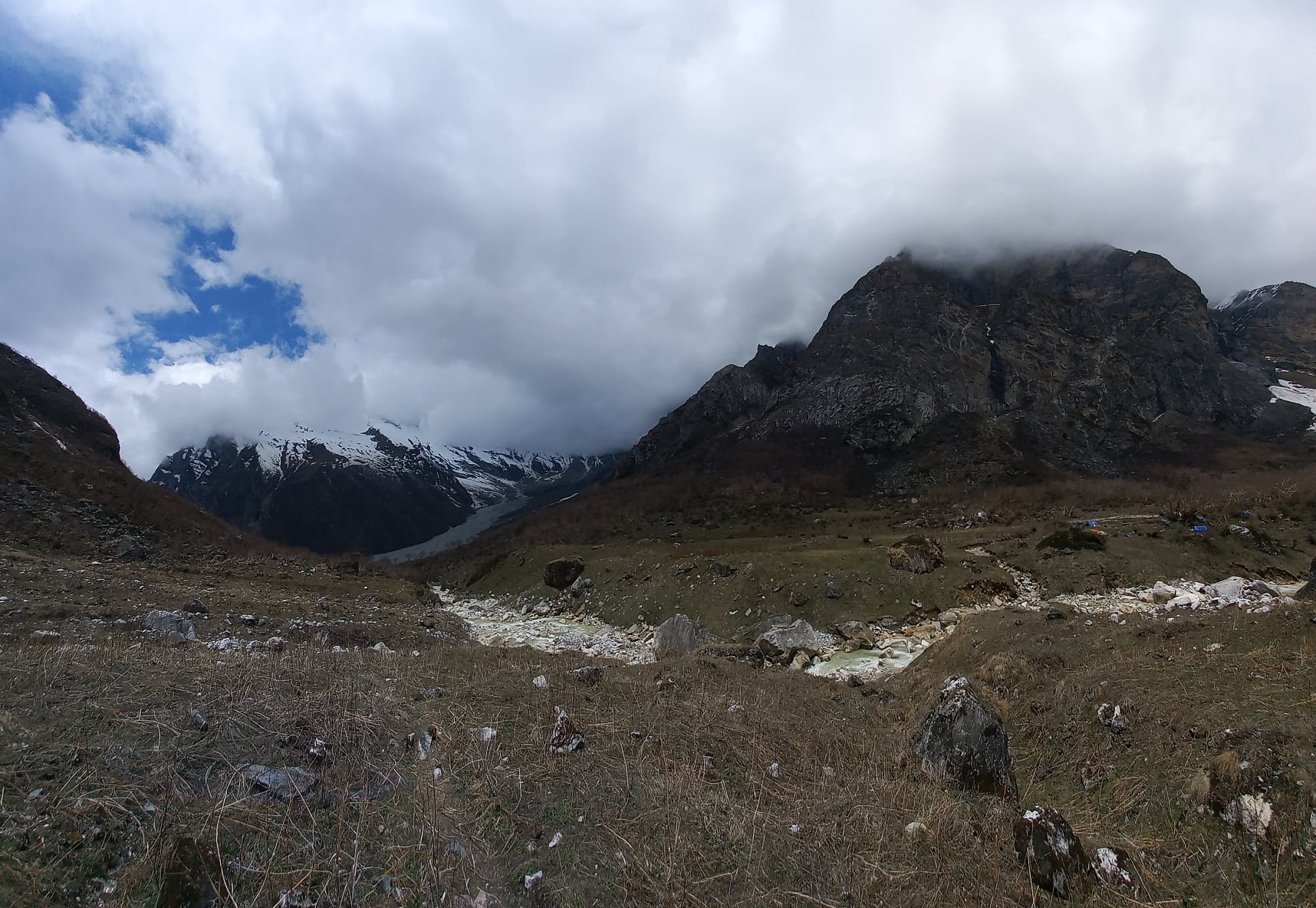
The entire snow of this glacier in Mdhungama, Saipal Rural Municipality, has already melted.
“Now, it’s hard to see glaciers. Once snow-covered areas are now turned into deserted land,” Bam Bahadur Bohara, a teacher in Saipal explains how climate change induced disaster is affecting mountain life. He estimates about 95 percent of the total glaciers have dried up in this region. Since snow is already disappearing in high passes downstream people have been facing an acute water crisis. Water is not adequate for irrigation.
A study conducted by Rural Water Resource Management Project, a Bajhang-based non-governmental, shows 40 percent of the total water sources dried up in the last seven years. “Even as ours was a small-scale study it shows how severe is the water crisis in Bajhang,” said one of project’s experts Pallav Raj Nepal.
Out of Nepal’s 77 districts Bajhang is the district with the most snow-covered areas. A total of 1,027 square kilometers area in the district remains above 5000 meters altitude. Mountain ecosystem has drastically changed due to rising temperature and human activities. This sort of change has complicated the livelihoods of mountain people mainly poor and women.
Disappointed by the devastating situation in the mountain Saure Bohora, 58, of Dhaulana, Saipal, has stopped going to the mountain to collect yarsagumba. “Mountain pass is not as it was in the past. Forest areas are all cleared. Situation is very frustrating,” said Bohara, a regular visitor to Raidhungi pass for the yarsagumba collection for the last 20 years, adding, “Smell of colorful flowers like chaap and chimalo is not available in the mountains these days.”
Dense forest in the villages of Saipal Rural Municipality namely Majha, Faralkhet, Kalapani, Raidhungi, Aulagad, Syangban, Nilkhutti, Dahchaur, Kalanga and Kholaga is all cleared. Situation is not different in villages Jaljala, Danfechuli, Tapoban, Danda, Thade, Jarsi and Goldhunga of Surma Rural Municipality. Forest in the areas of Thanpatan, Dhaula Dhunga, Chupi, Chaligad, Thadigad, Bhide in the Bungal Rural Municipality is decreasing rapidly. Forest encroachment is high in mountain villages of Durgathali, Chhabis Pathibhera, Masta, Tallokot rural municipalities and Jaya Prithvi Municipality.
“While reaching there in high passes for yarsagumba collection wooden poles required to fix tents used to be available everywhere,” said Pabitra Bohara, a local from Surma Rural Municipality adding, “These days, we have to walk six to seven hours to collect firewood. We will have to come up with cooking gas while going to the mountains in the future,” she said.
Some five years ago Pabitra used to go to high pass just two days before starting the yarsagumba collection. But she has to leave home 15-20 days before the actual yarsagumba collection begins as she has to spend weeks to collect firewood required during her stay in the mountain.
Yarsa collectors destroyed forest
Until a decade ago, people weren’t aware about the economic value of yarsagumba so searching for the precious fungus wasn’t a priority. Very few people used to go to the mountain for the yarsagumba collection. No human pressure at all in mountain regions. But people living under extreme economic pressure since a decade-long Maoist insurgency started to collect yarsagumba and other herbs shortly after the rebels signed a peace deal to join mainstream politics.
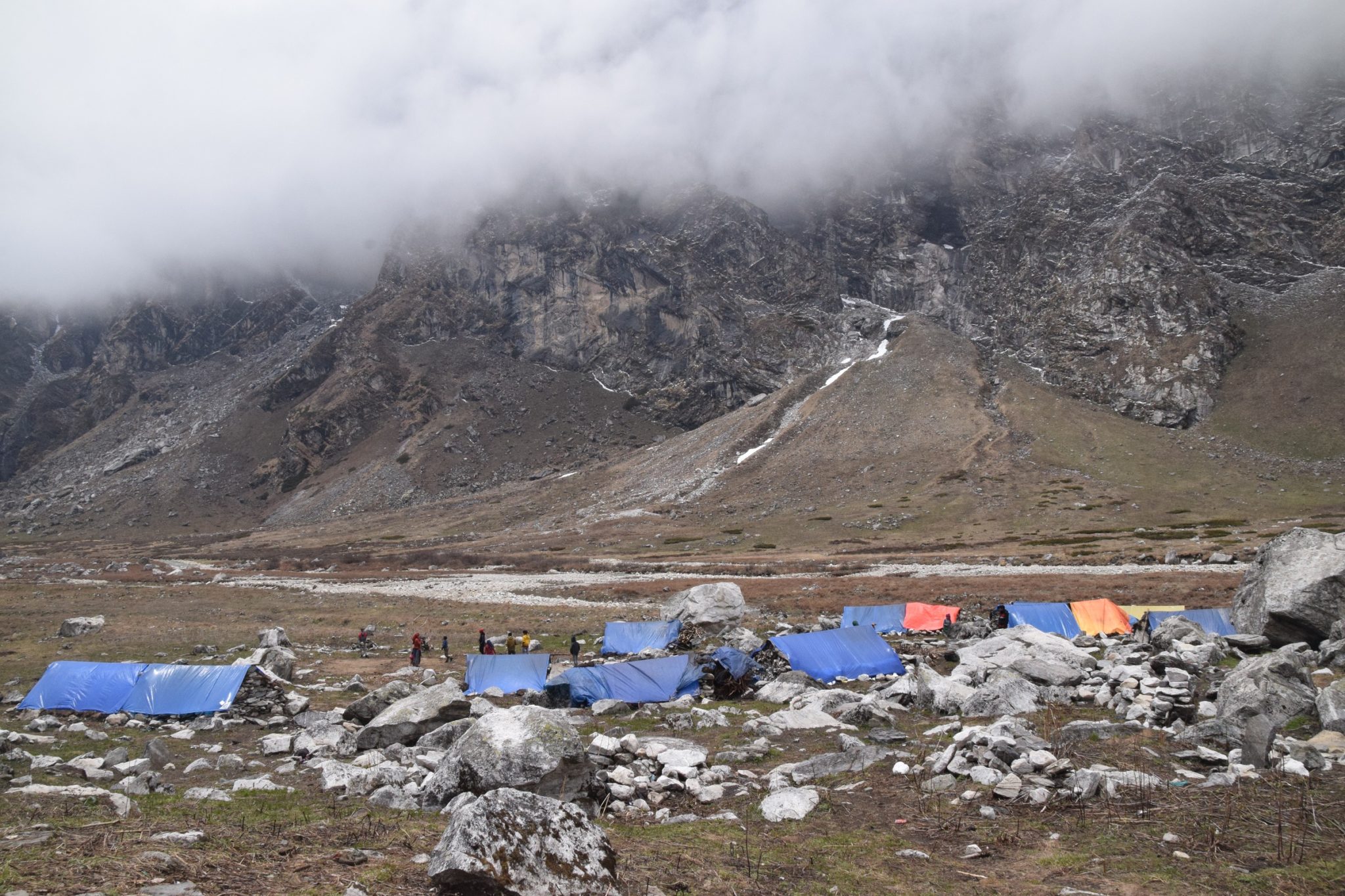
Yarsagumba collectors have set up tents at lower Raidhungi of Saipal Rural Municipality. This area was covered with dense forest some five years ago.
Every year, about 48,000 people go to mountains for yarsa collection, according to local government records. Locals estimate the number of yarsa collectors was far less ten years ago although no official records were available then
“Except a few from neighboring villages used to come, only we people from the village development committee used to go to the high passes for herb collection,” said Bir Bahadur Jethara, a local of Surma, “These days, you encounter with people from all 77 districts in high passes.”
Unlike the past, people arriving for yarsagumba collection cut trees for 10-15 days before starting actual herb collection works to ensure firewood during their three months stay in mountains. “When thousands of people chop down trees for firewood a jungle gets completely destroyed within a single yarsagumba harvesting season,” said yarsa collector Runche Bohora.
Yarsa collectors cut down mountain trees like Bhuchimalo, Bhojpatra, Chimalo, Chhap, Dhupi, Lekkuyali, Pangrato and bushes. According to Bohara, herb collectors destroy Dalechuk, Machhyango, Kalobhoj, Rayas and Bayojodi Chngwa.
A study conducted by ICIMOD shows mountain areas are deforested during the yarsa collecting season. As per the study even if six people take shelter under a tent they require 12 kg of firewood daily. About 15,000 tents are set up in the mountains of Bajhang during the season.
If ICIMOD study is anything to believe, yarsagumba collectors consume 16,200,000 kgs of firewood during their three months stay in high passes. Since mountain trees are medium-sized it is estimated that yarsagumba pickers destroy 648,000 trees in a single yarsa harvesting season.
Apart from yarsagumba collectors, thousands of people remain in the mountains for four months starting from August to collect other herbs every year. They also destroy the jungle for firewood. During their stay in high passes people assembled from Rukum, Rolpa, Salyan, Dailekh, Jajarkot, Humla, Jumla, Surkhet, Dolpa, Darchula and Bajura among others districts for herbs collection also cut down precious Jatamasi, Katuki, Setakchini and Bhutkes trees. Some trees are used to purify ores.
“Entire trees are put into kilns to purify setkachini,” said Jayadhan Dhami of Bungal-1 Dahabagar adding, “Hundreds of such trees can be seen burning in kilns.”
Such activities, according to him, destroy dense forest within a few days. Traders say about 100,000 quintals of setkachini was collected in Bajhang last year. Dhakpa Lama, an herb trader, says about 4 kgs of firewood is required to purify a kg of setkachini. If his statement is anything to believe, as many as 40,000,000 kg of timber were required to purify setkachini in the last two years. No independent study has been conducted so far to this effect.
Wildlife disappearing
Kul Bhan Bohara, former chief of Village Panchayat, says former royal family members and foreigners used to visit Bajhang between 80s to late 90s taking their helicopter for wildlife hunting. “Hunters arrived on a hired helicopter even later. Some used to set up tents and stay there for a couple of days. Others used to return within three to four hours after killing wildlife –jharal and naur,” says Bohara, “It’s hard to see wildlife these days in Bajhang, previously known as a hunting spot.”
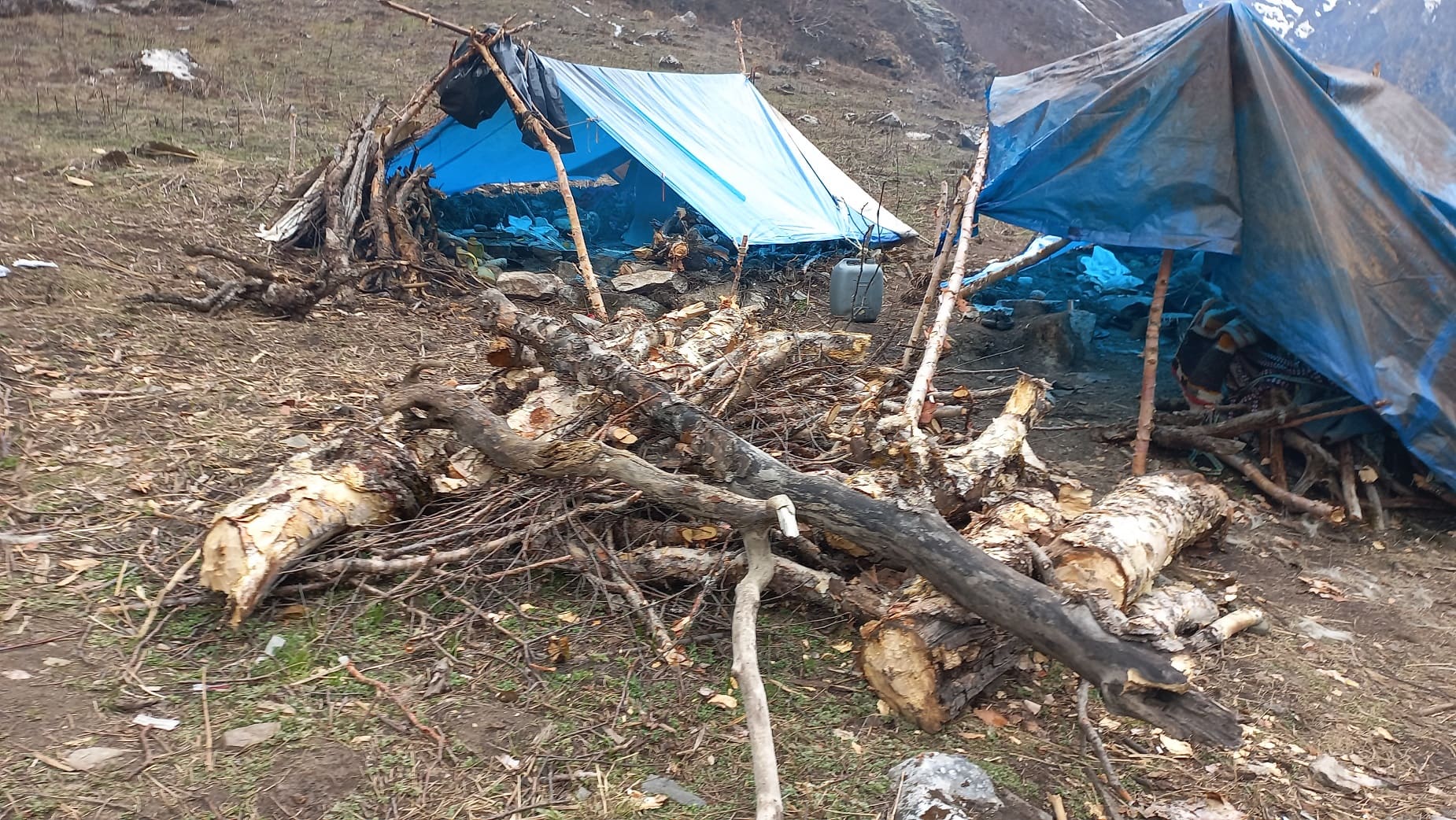
Trees cut down by Yaragumba collectors for firewood purposes.
Suresh Ghimire, a professor at the Central Department of Botany, Tribhuvan University, says wildlife and birds are disappearing faster than expected as deforestation goes unchecked. “Pine forest is a key habitat and grazing area for musk deer. When there’s no pine tree it impacts musk deer,” he said, “No forest no wildlife. Entire ecosystem will change even if a single wildlife or plant disappears in the mountains.”
Ghimire says forest in high passes that remains covered with snow for six to eight months in a year is very sensitive. “It takes time to grow plants in cold areas,” he says, “It takes 20 years to grow plants in high mountain areas as tall as it grows in hill and mid-hill areas within two years.”
Since deforestation poses a risk of landslides in mountain areas, Prof. Ghimire, predicts deforestation in mountain regions will invite severe disasters in the region. “We will have to wait for hundreds of years to revive forest in recently deforested areas,” Dr. Binaya Pasakhal of ICIMOD says urging the locals to take immediate lead in forest management, “Plantation doesn’t sound practical. Managing human activities is the only alternative,”
Herbs scarcity means real crisis for people
Herb species are declining rapidly in the mountain forest so Joban Bohara of Saipal is much worried about it. “Entire hilly area looks naked. People have over extracted plants, some of them are picked even before maturing. Everything is gone,” he says.

Tents fixed by sheep herders in Aaulgad region of Saipal base camp. The glacier seen in the picture is disappearing. This area was covered with forest a few years ago.
Records of the Division Forest Office show herbs in mountain regions are declining. Precious ban lasun, setkachini, musli, katuki and jatamansi, that fetch between Rs 800- Rs 1200 per kg, are on verge of extinction. In 2012, 8,600 kg of satuwa was exported whereas Bajnag was able to export only 2,225 kg in 2014. The export was reduced to 1530 in 2018. Aimed at preserving satuwa the then district development committee banned its export. People are importing it illegally. About 4,000 kg (worth Rs 40 million) of ban lasun, another previous herb, was imported in 2016. But its export amount was reduced to 900 kg in 2018. Currently, the government has banned the export of the endangered herb.
Bajhang, according to the Division Forest Office, exported 24 – 30 types of herbs from the districts in 2008. But the number of such herbs has now reduced to eight in recent days. Due to overharvesting, the production of yarsagumba has declined by 30 percent, it’s stated. That’s why the fungus was included in the IUCN Red List as a vulnerable category
“This is one of the few documented cases of a fungus being threatened by overharvesting,” said Prof Gregory Mueller, Chair of the IUCN SSC Fungal Conservation Committee in July 2020. He has stressed on the need of Implementing a sustainable harvest program that is needed both for the Chinese Caterpillar Fungus and for the long-term economic health of the communities that depend on it for income.
Prof. Ghimire says bushes, herbs and grass grown under the shadow of trees disappear once the tall trees are cleared. If pine trees are cut down mountain flowers also disappear which directly impacts the lifestyle of butterflies. ICIMOD’s scientist Pasakhala says the impact of deforestation was seen in yarsagumba production too.
“Yarsagumbas are formatted from larvas of butterflies and when natural habitats and flowering plants disappear it affects entire lifecycle of yarsagumba and its production.”
Karna Bahadur Khati, officiating chief at Division Forest Office, says all types of herbs are declining in the mountains of Bajhang. Reproduction of precious herbs is largely affected because of overharvesting and deforestation. As their source of income dwindles in home villages locals are forced to return to India and Gulf nations seeking job opportunities.
Because of deforestation sheep keepers in the villages of Saipal, Surma, Talkot, Masta, Khaptad Chhanna and northern part of Jaya Prithivi and Bungal municipalities are suffering the most. Five years ago, 650 households had about 60,000 sheep but the number has reduced to 14,000 with only 150 families continuing sheep keeping.
Returning to India yet again
Prithivi Singh of Kailash Village Development Committee had touched 10 when he went to Simla of India to work as menial worker. Since then, he worked six months in India and six months in Nepal for 33 years. In 2010, he eventually stopped going to India. Reason: he started harvesting wild herbs yarsagumba available around his home village. He used to earn Rs 300,000 to 400,000 annually. His earnings were good enough to feed eleven other mouths. Yet, he built a concrete house. But his lucrative earning at home village didn’t last for long.
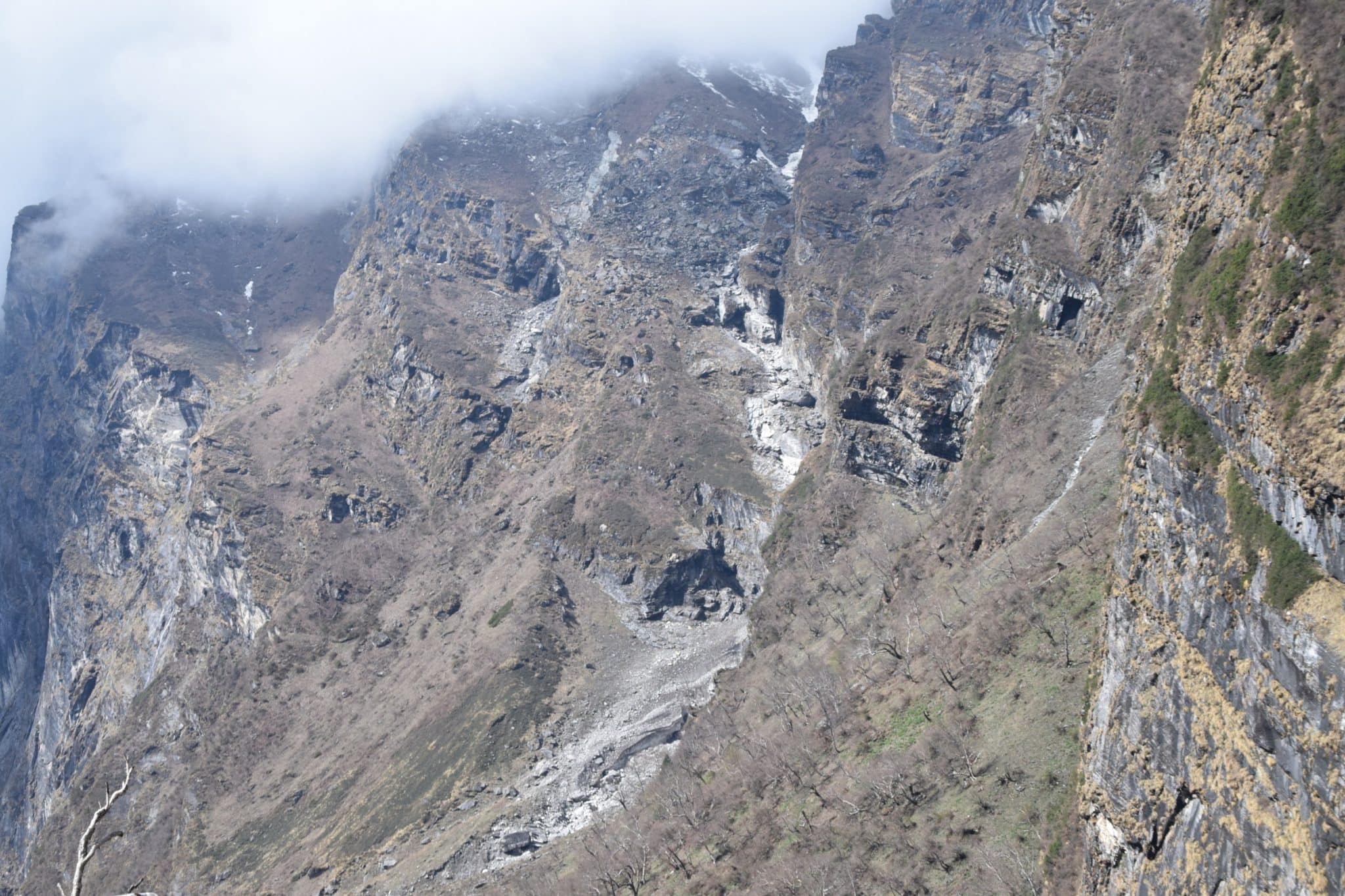
Mountain looks dry in Raidhungi of Saipali after nearby glaciers dried up there.
Prithivi, now 71, has started to go to India to work as a menial laborer. “Herbs disappeared. I have no other options but to go to India to ensure livelihood,” he says
The number of seasonal migrant workers to India declined significantly after 2008. “Some seven to eight years ago, not a single person was going to India. Now, there are no herbs in the jungle so it’s hard to see males in villages,” says Karna Kathayat, chairman of Masta Rural Municipality.
Access to herb not only stopped the people from going to India, it drastically changed the lifestyle of people staying in remote villages like Surma, Saipal and Bungal. Each family member used to annually earn Rs 300,000 to 400,000. “Those unable to have meals twice in a day-built house in district headquarters or Tarai, sent their children to private school. The earning was out of their expectation,” said Ganesh Bohara of Surma village.
Bohara says some families have now sold land and houses built in city areas failed to bear increased expenses. The land price soared with good earnings of locals has now declined again. Unable to afford the fee, locals have transferred their children to government schools from private ones. About 20 households from Bohara village have left house construction incomplete despite spending five years.
Sher Bahadur Bohara, a herb trader, says annual herb transactions in the district were about Rs 4 billion some five years ago. The trade has now reduced to Rs 300 million. “Herb transactions plunged as its production declined. Livelihood of tens of thousands of people is now at stake,” he says.
A study conducted by the Social Development Ministry of Sudurpaschim Province in 2018 shows the number of seasonal migrant workers heading to India was 206,000. The number of migrant workers has increased further in recent days.
5,000,000 beer bottles left in mountains
High passes, whom locals worship as god, are filled with garbage and beer bottles after herb collectors tens of thousands of people started to gather there to harvest natural resources beyond the limit. None has taken an initiative to control overharvesting of herbs.

People collecting yarsagumba in Majaban of Saipal.
Her collectors reach high passes with single-used plastic items and clothes and return leaving them in the mountain. In absence of proper monitoring, high passes of Saipal and Surma have turned into garbage dumping spots. “Garbage pile up is growing taller every year,” said Lakhan Bohara, a local, “High Mountain passes are converted into garbage dumping sites.”
A study carried out by the ICIMOD in areas of Saipal Rural Municipality where yarsagumba are available, shows more than 40,000 quintals of garbage piled up in mountain areas. If other herb collection areas of the district are taken into account about 160,000 quintals of garbage should be piled up in Bajhang, it is estimated.
According to the study conducted two years ago in partnership with local non-governmental organization, Sahara Nepal, a person abandons more than 10 kg of waste—sandless, tents and bedding items and an additional cover of biscuits, noodles, juices, chocolates and tobacco. About 40,700 quintals of garbage have been dumped in the last 15 years.
Pile of beer bottles has emerged yet another type of garbage piling up in the mountain pass. Citing a study conducted 15 years ago Gyan Bahadur Bohara, head of Sahara Nepal, estimates as many as 500000 beer bottles should be unattended in Bajhang.
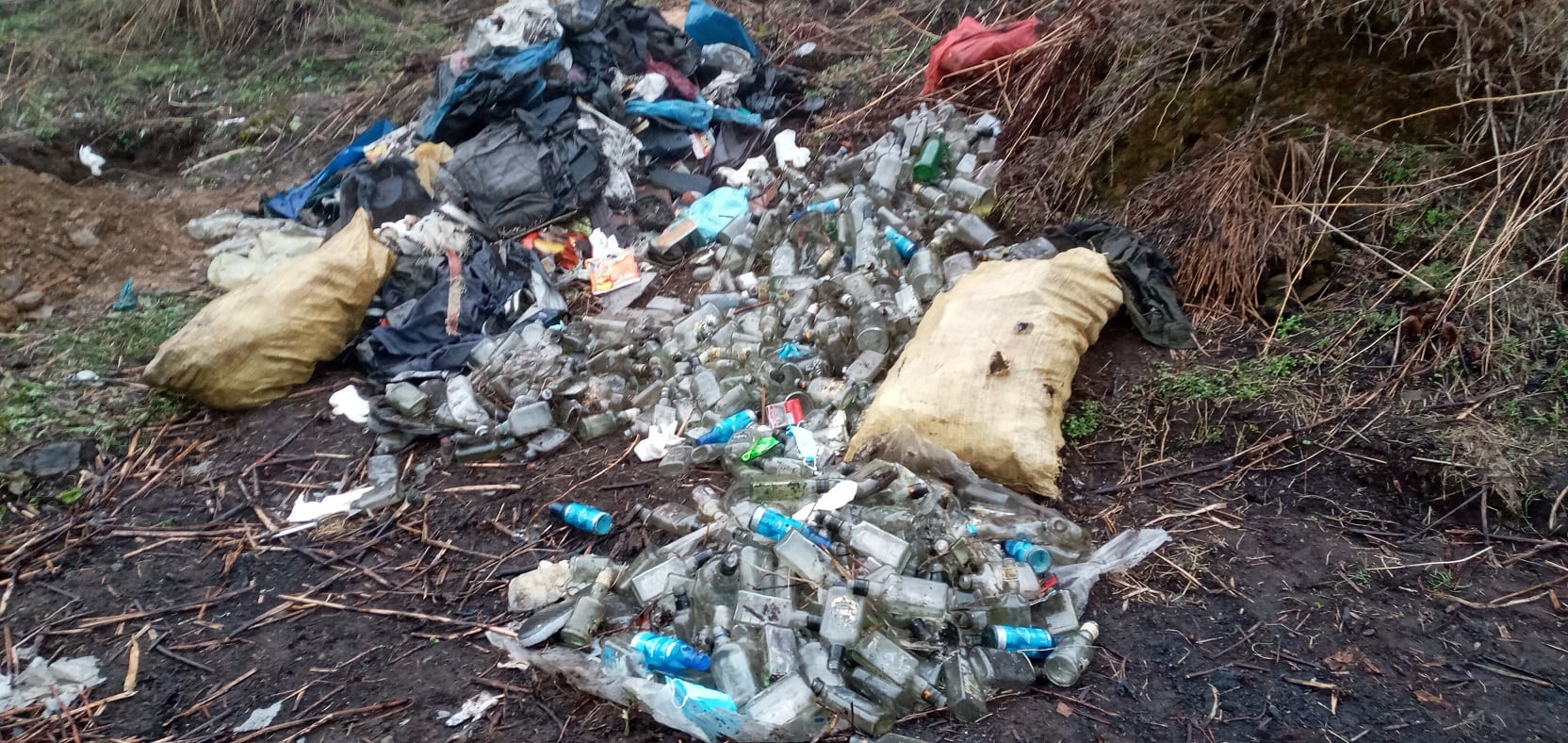
Garbage piled up near Saipal mountain.
“If all bottles left in mountains are to be taken into account in our previous account more than 40000 quintals of garbage has piled up in the mountain pass of Saipal,” said Bohara adding, “If garbage continues pile up in the mountain this way mountain passes once known for precious herbs will be filled plastic bottles, beer bottle and garbage.”
As garbage continues to pile up in the high mountains, mountain biodiversity is largely affected. Stakeholders call authorities to take immediate actions in controlling garbage.
Uttaam Babu Shrestha, director at Global Institute for Interdisciplinary Studies, says wildlife face serious health impacts after consuming plastic and chemical-laced stuff. It takes time to dispose of waste in the mountains.
“Leave other garbage, it affects mountains even if we are unable to manage human urine,” says environmentalist Bhusal Tuladhar stressing on the need of conducting immediate research on impact of pollution in mountain ecosystems.
Fast changing climate conditions in the mountains cause landslides and damage newly constructed infrastructures. Ghatganga stream sweeps away the road connecting Saipal base camp. Flood damaged Khahare-Dhakichada road section constructed just two years ago by investing Rs 1 million was. Last year, local authorities constructed another route as the previous one was damaged by flood.
Last year, floods swept away a small hydro project worth millions of rupees and 23 wooden bridges, according to Saipal Rural Municipality chairperson Rajendra Dhami. The local body annually needs to invest Rs 5 to Rs 6 million to construct and repair wooden bridges like small infrastructures damaged in floods and landslides.
Negligence
Despite knowing that the crisis induced by environmental destruction has hugely affected the mountain areas, all three sets of governments haven’t shown their interests in initiating intervention to stop further damage. Even as Saipal Rural Municipality has introduced yarsagumba harvesting guidelines, remaining local governments are completely ignoring the issue of environmental degradation.
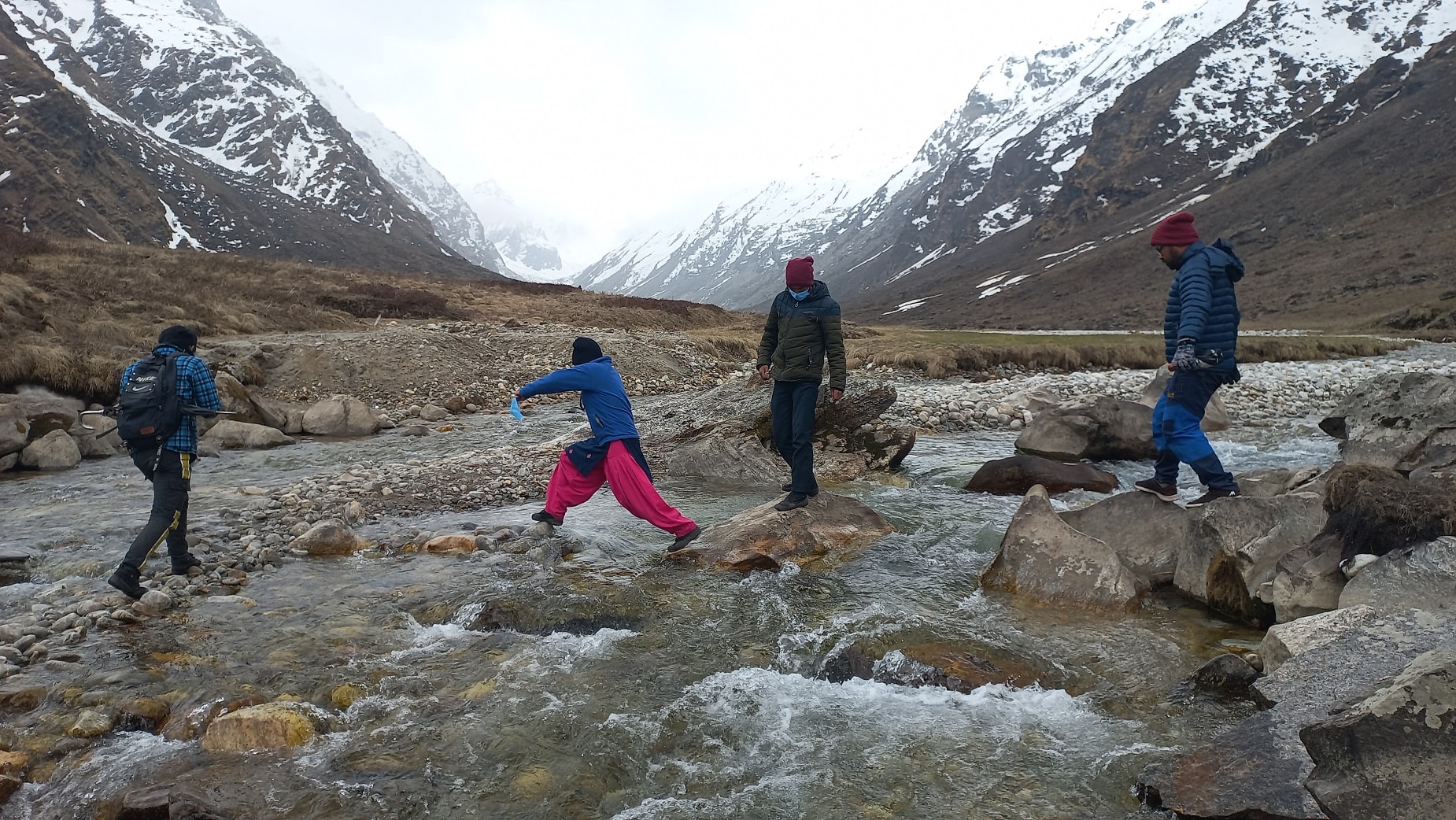
People crossing the local glacier. This glacier used to remain frozen till mid-June some five years ago.
Elected people’s representees admit their failure in giving prominent priority to environmental issues like other issues such as health, education and infrastructure construction. “Everyone is asking for the construction of infrastructures. It’s our fault for not thinking about the climate change crisis and livelihood issues caused by environmental degradation,” said Dhami adding, “Handling the climate crisis may be beyond our capacity but we must take concrete action in destruction happening because of human activities.”
Nar Bahadur Bohara, chairman of Surma Rural Municipality, which collects the second largest amount of yarsagumba after Saipal, says the situation in his area is already out of control. “We are unable to stop deforestation, collection of herbs before they are fully matured, control wildfire and wildlife poaching,” said Bohara, adding that local authorities have stopped working as their previous efforts to protect herbs and wildlife went futile.
Arguing the local governments lack resources to conserve mountain ecology he urged provincial and federal governmental governments to step in.
Dhan Bahadur Bista, chairman of Bungal Rural Municipality, which stands in second position after Saipal in terms of herbs collection, says the environment conservation issue is getting complicated as local governments are not empowered to work in forest conservation.

Herb collectors heading towards mountain pass carrying essential logistics.
“Even as responsibility of forest conservation is our responsibility, this actually doesn’t fall under our jurisdiction legally,” said Mayor Bista, “We have banned collection of endangered herbs but the traders obtain collection permits from Division Forest Office and collect herbs haphazardly.”
Mayor Bisa accused the provincial forest ministry of not taking any initiatives despite repeated requests to work for forest conservation in the mountain region.
“It’s already too late to raise this issue.”
The Sudurpaschim Provincial Government which comes with popular slogans while unveiling annual policy and programs each year in herbs collection, processing and expanding herb farming has not taken any action in controlling irregularities happening on the ground.
“The provincial government hasn’t given due priority due to lack of policy infrastructure and lack of workforces,” said Bharat Prasad Shrestha, spokesperson at the Industry, Tourism, Forest and Environment Ministry of the province, “We are now drafting forest regulation based on forest act. Hope this will help to resolve some of the underlying problems.”



